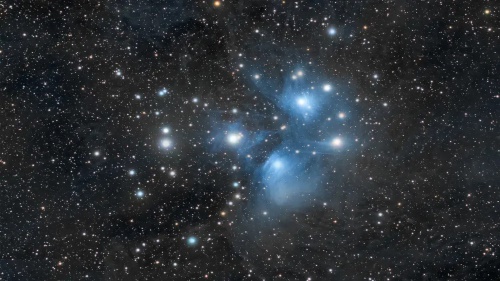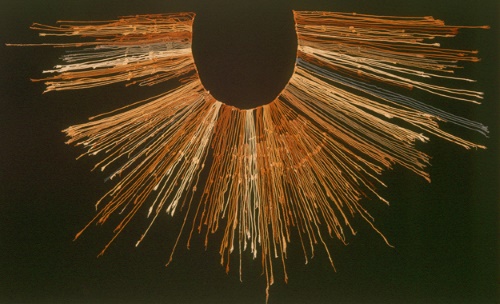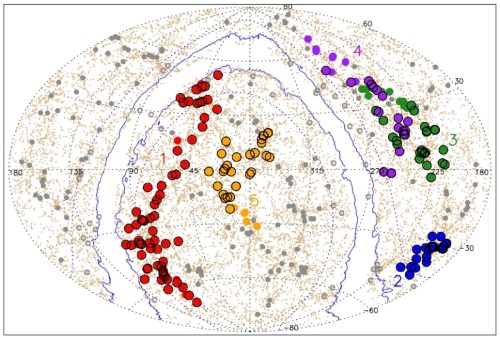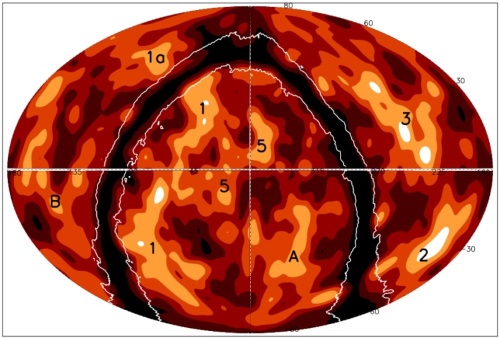Astronomers have made a groundbreaking discovery, unveiling Quipu - the largest known cosmic structure, spanning an astonishing 1.3 billion light-years. This colossal superstructure challenges our current understanding of the universe's large-scale structure and its impact on cosmic evolution.
Named after an ancient Incan recording system, Quipu represents a massive concentration of matter, holding profound implications for our understanding of cosmic evolution. This discovery challenges existing cosmological models and presents a unique opportunity to refine our knowledge of the universe's formation and growth.
Quipu's discovery has sent ripples through the astronomical community, as its existence pushes the boundaries of our current cosmological models. This monumental finding provides a unique opportunity to deepen our understanding of the universe's formation and evolution.

Source: thebrighterside
Here is an Overview of a Quipe:
- Discovery: Identified by astronomers mapping the universe from 425 million to 800 million light-years away.
- Size & Composition: Contains 68 galaxy clusters, with a mass equivalent to approximately 200 quadrillion stars.
- Significance: Distorts cosmic observations and affects calculations related to the Hubble constant and cosmic microwave background (CMB).
- Future Evolution: Expected to fragment over time into collapsing units due to cosmic expansion.
Naming & Cultural Connection
The structure is named Quipu after the Incan knotted cord recording system, as its shape resembles knotted threads. The name also honors Chile’s European Southern Observatory, where many redshift measurements were taken.
| Name | Origin |
| Quipu | Incan system of recording data using knots |
| Hercules-Corona Borealis Great Wall | Another vast structure, but its connectivity is unconfirmed |

Source: earthsky.org
What is the Structure of Quipu?
Quipu appears as an extensive filamentous network in which it is like Primary filament which is a long, thread-like arrangement of galaxies. From Side filaments, it has Smaller branches extending from the main structure. It is Invisible to the naked eye but prominent in galaxy cluster sky maps.

Source: earthsky.org
Quipu Discovery Methodology
The discovery of Quipu was made possible through the Cosmic Large-Scale Structure in X-rays (CLASSIX) Cluster Survey. Researchers utilized X-ray emissions from hot gas found within galaxy clusters, which helped to identify regions of mass concentration.
How the discovery was made?
X-ray Emissions: Hot intracluster gas emits X-rays, revealing the mass concentration in superstructures. Astronomers used these emissions to map the densest regions of matter and identify superstructures like Quipu.
Significance of the Quipu Structure in the Universe
The discovery of Quipu is vital for understanding the evolution of galaxies and the cosmos itself. By studying Quipu, astronomers aim to refine cosmological parameters, including how gravity shapes the universe. Let's explore its significance in detail:
- Largest Cosmic Structure: Discovered in 2024, the Quipu structure spans 1.2 billion light-years, making it one of the largest known structures in the observable universe. It challenges existing cosmological models that suggest a limit to cosmic structures based on the Cosmological Principle.
- Challenges the Cosmological Principle: The Cosmological Principle states that the universe is homogeneous and isotropic on a large scale. The existence of such a massive structure suggests potential deviations from this principle, requiring a re-evaluation of standard cosmological theories.
- Composition and Structure: The structure consists of galaxy filaments connected in a pattern similar to cosmic "threads," much like how Inca Quipu cords were arranged. It is made up of galaxy clusters and superclusters, interconnected through the cosmic web.
- Insights into Large-Scale Cosmic Evolution: Helps scientists understand the distribution of dark matter and the role of gravitational interactions in shaping the universe. Provides new clues about how large-scale structures formed and evolved over billions of years.
- Potential Link to Cosmic Filament Theory: Supports the cosmic filament theory, which suggests that galaxies are not randomly distributed but rather arranged in a vast, web-like structure. The Quipu structure provides observable evidence of how matter is distributed on a massive scale.
What will be the Impact of Quipu on Cosmology?
Superstructures like Quipu will have an impact on Cosmology in two ways, i.e. Gravitational and cosmic expansions.
- Gravitational Effects: Quipu’s mass influences the Cosmic Microwave Background (CMB), affecting measurements of the Hubble constant.
- Cosmic Expansion: These gravitational alterations complicate our understanding of the universe's expansion and its early conditions.
What Are Superstructures?
Superstructures are enormous formations in the universe that consist of galaxy clusters and superclusters. These formations are key to understanding how the universe has evolved and how galaxies are distributed across vast distances.
Key Points about Superstructures:
- They influence the structure and evolution of the universe.
- Superstructures like Quipu play a central role in shaping cosmic structures.
- Quipu, along with four other superstructures, holds a significant portion of the universe's matter and galaxies.
Mapping the Nearby Universe
The discovery of Quipu is part of an ongoing effort to map large-scale cosmic structures. Researchers employed X-ray surveys and galaxy cluster mapping to trace these superstructures.
| Survey | Coverage & Purpose |
| CLASSIX Survey | Mapped galaxy clusters in X-rays across 86% of the sky |
| 2MASS Redshift Survey | Provided detailed galaxy density distribution |
| Cosmic Flow Data | Helped refine distance and velocity measurements |
The Five Superstructures
In addition to Quipu, astronomers identified four other major superstructures. Collectively, these five formations contain 45% of all galaxy clusters, 30% of galaxies, and 25% of the universe’s matter.

Source: earthsky.org
Superstructures and their Impact on Cosmology
These massive structures influence fundamental cosmic observations:
- Distortion of the Cosmic Microwave Background (CMB): Through the Integrated Sachs-Wolfe Effect, causing subtle fluctuations.
- Impact on the Hubble Constant: Local mass variations alter our measurement of the universe’s expansion rate.
- Gravitational Lensing: Bends light from distant objects, affecting astronomical imaging.
Conclusion
The discovery of Quipu redefines our perception of cosmic structures, providing crucial insights into the universe’s large-scale formation and expansion. As technology advances, astronomers anticipate even more discoveries that may further reshape our cosmic understanding.
Comments
All Comments (0)
Join the conversation